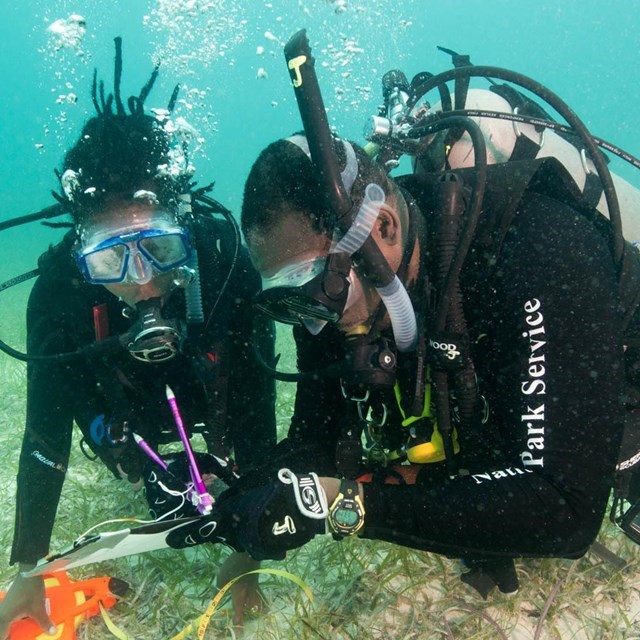Last updated: September 20, 2018
Article
Partners in Preservation: Volunteer Underwater Archaeology

Image Courtesy of National Park Service
Volunteers have worked with universities, nonprofit organizations and government agencies to present shipwreck sites to the public. They have stretched meager institutional budgets, and added expertise in supporting fields--all the while enjoying themselves! Following are highlights from the work of some of the hundreds of volunteer groups who have supported underwater archeology in Florida.
New diving technologies have made the historic shipwrecks of Florida accessible to more and more people in the last 50 years. The biggest change was the development of the self-contained underwater breathing apparatus (SCUBA). This opened up hundreds of shipwrecks to visitation or exploitation. SCUBA allowed archeologists to perform careful scientific excavations of shipwrecks which led to the documentation of many more important underwater sites, both prehistoric, and historic. Among the first groups of archeologists working in Florida was the Anthropology Department at Florida State University (FSU) which began archeological work on shipwrecks in the mid-1950s. Working with students, volunteers and government employees, FSU has documented dozens of shipwrecks throughout the state. The Archaeology Institute Maritime Archaeology Program of the University of West Florida has been active in shipwreck research in the last few years. It's efforts with the state, interns and volunteers have been essential in work on the Emanuel Point shipwreck, and the Santa Rosa Island wreck.
The National Park Service's Southeast Archeology Center (SEAC), in Tallahassee, Florida, began an underwater archeology program in 1972 taking advantage of its proximity to coastal parks and its established partnership with Florida State University's underwater archeology program. SEAC conducts shipwreck investigations with FSU through field schools on sites including the HMS Fowey (lost in 1748), Nuestra Senora del Populo and Nuestra Senora del Rosario. SEAC has worked with student interns, volunteers and universities on a number of Florida shipwrecks. The National Park Service's Submerged Resources Center was formed in 1980 and is devoted exclusively to work on submerged archeological sites. The Center has worked with volunteers and university archeology programs around the world. In Florida, the Center worked with multiple partners on the Boca Chica Channel wreck near Key West and the multiple shipwrecks of Dry Tortugas National Park, Biscayne National Park and Gulf Islands National Seashore. The Center's site reports of investigations are a fascinating way to learn more about the history and archeology of shipwrecks.
The Florida Bureau of Archaeological Research leads efforts to protect shipwrecks submerged in state waters. Florida was one of the first to establish a state underwater archeology office and has engaged multiple partners to help it perform its mission. The Bureau answers questions about discoveries made by sport divers and amateur archeologists and manages the Shipwreck Preserves Program, where the public can visit some of the state's most interesting shipwrecks. Currently there are 11 shipwreck preserves, each nominated by nearby communities who partnered with the state to develop the site as an interpreted attraction. Each preserve is designated with a bronze plaque, and offers brochures, underwater guides and a shore-based exhibit. The state has a formal agreement with the Florida Keys National Marine Sanctuary to advise them on the management of submerged cultural resources in the sanctuary. The state has also produced a comprehensive Florida Maritime Heritage Trail that includes other types of maritime resources, such as lighthouses, besides the shipwrecks included here.
A good example of the way in which volunteers make a difference in underwater archeology is the SS Copenhagen. previously missing its entire bow section. More than a year after designation as a Florida Shipwreck Preserve in 1994 local divers found a bow that they suspected might be that of the Copenhagen. Working with the state, a nonprofit group, Marine Archaeological Research and Conservation, Inc., (MARC), identified the bow as matching the rest of the ship. MARC continues to be one of the most active volunteer organizations working in the field of shipwreck preservation and archeology.
State archeologists have helped train MARC and other volunteer groups in archeological mapping techniques to help broaden knowledge about shipwrecks in state waters. Volunteer divers from a Bradenton Beach Dive Shop have developed extensive maps of a wreck that is usually covered in sand, working to record what is uncovered by each new storm. They have produced a fine site drawing of the molasses barge Regina (not yet listed in the National Register)--data that would be difficult to acquire without knowledgeable local volunteers.
One shipwreck research saga began in 1984 when Jacksonville dentist Dr. Keith Holland and St. John’s Archaeological Expedition, Inc. located and began excavations on the Civil War U.S. Army transport Maple Leaf. The steamship was sunk when it ran into a Confederate minefield on the St. Johns River near Jacksonville in 1864. On board were the supplies of three Army regiments and several merchants who sold goods to soldiers. A preliminary investigation proved the wreck to be well preserved beneath the river mud. Realizing the tremendous historical value of the find, they called for professional backup and were joined by archeologist Frank Cantelas (from East Carolina University) and students. Lee Manley, an experienced professional diver, trained in conservation, was the project director from 1985 until his death in 1988. As the cost for storage and conservation mounted beyond the ability of the volunteers and the university to support, the Florida legislature provided substantial funding and the Jacksonville Museum of Science and History exhibited the collection. The Museum of Florida History in Tallahasseemanages a traveling exhibit on the ship. The Maple Leaf project remained primarily a volunteer effort and is an extraordinary achievement by this partnership of private, academic and government people, money and time.
The opportunities to volunteer are endless, as are the benefits. Individuals with interest and expertise in diving, history, archeology and shipwrecks have made a great contribution to the recreational and educational opportunities and historic preservation of Florida and its rich legacy.
